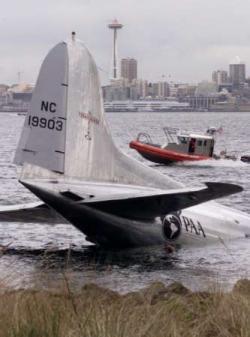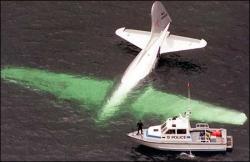Jesus cried with a loud voice, "Lazarus, come forth!" - John
11:43
By ANN Correspondent Kevin "Hognose" O'Brien
 The Boeing 307 Stratoliner was the
hit of the show at Airventure 2001, and it was never supposed to
come to Oshkosh again. The historic pre-war pressurized airliner,
the only one in the world, had just completed a painstaking
six-year restoration to flying status. By Airventure 2002, though,
its flying days were supposed to be over: it would be embalmed and
ensconced in the National Air and Space Museum's beautiful new
Udvar-Hazy Center at Dulles, while curators there built an exhibit
around it in anticipation of the Center's Centenary of Flight
opening.
The Boeing 307 Stratoliner was the
hit of the show at Airventure 2001, and it was never supposed to
come to Oshkosh again. The historic pre-war pressurized airliner,
the only one in the world, had just completed a painstaking
six-year restoration to flying status. By Airventure 2002, though,
its flying days were supposed to be over: it would be embalmed and
ensconced in the National Air and Space Museum's beautiful new
Udvar-Hazy Center at Dulles, while curators there built an exhibit
around it in anticipation of the Center's Centenary of Flight
opening.
But as bittersweet as such a Lenin's tomb fate might be, for a
while things looked a lot worse for the Boeing. After narrowly
escaping the scrap-heap fate of its nine sister ships, the plane
underwent a the costly restoration that climaxed with the June 23,
2001 rollout of the completed machine and its triumphal Airventure
arrival, which saw it prominently displayed on AeroShell Square at
show centre.
But on March 28, 2002, a routine test/training flight ended, not
on the runway, but in the corrosive salt water of Elliot Bay. No
one was hurt in the textbook ditching, and one of the crew was seen
stepping off of the semi-submerged machine onto a rescue boat,
briefcase in hand, dry and unruffled. But the insult of a ditching
in front of all downtown Seattle (caused by fuel exhaustion: NTSB
report here:
http://www.ntsb.gov/ntsb/brief.asp?ev_id=20020401X00435&key=1
) was added to the injury of, first, the impact
with the water, and secondly, the ravages of saltwater
corrosion.
The once-pristine liner was hauled up on shore and frantically
flushed out with fresh water, but the prognosis for any airplane
immersed in salt water is not good. Kind of like Lazarus's, in
fact. At first, the job looked impossible; the volunteers that
initially rebuilt the plane, mostly Boeing retirees, were
discouraged and dismayed. But there was enough desire to rebuild
the plane, that Boeing OKd a survey. From that, a plan of attack
shaped up.
"We can rebuild it -- we have the technology!"
Boeing cracked open a nearly bottomless checkbook. The
volunteers were reinforced by Boeing employees. Engines and systems
were removed and shipped to overhaul shops. Parts that were common
to the B-17G were wheedled from reluctant warbird rebuilders. When
an airframe part was too far gone with damage or corrosion, the
volunteers did what they had done the first time: got the original
drawing from the Boeing archives, and followed the 65-year-old
callouts to make the part again.

And so, N19903 took shape, in the same building (historic Plant
II), for the third time in its eventful life. Not many planes that
the NTSB calls "substantially damaged" ever fly again, especially
not unique, large transport aircraft that are old enough to be
collecting Social Security. We can all be glad that the volunteers
and Boeing employees took this time out of their busy lives and
careers, and that Boeing was willing to support this rebuild, not
once, but twice. (Boeing's support went far beyond financial,
personnel and drawings... the machine was rebuilt in a Boeing plant
with company-furnished materials and tools, and the company made
too many other contributions to list. Heck, they could almost be
forgiven for moving their headquarters to aviation-hating
Chicago).
If it were not for Boeing, this plane might have met a fate like
its sister, NX19904. Built for a planned around-the-world flight
for Howard Hughes, it ultimately wound up selling as scrap for $62,
and parts of its fuselage incorporated in a yacht named "Cosmic
Muffin."
Why all this fuss about one airplane?
 What's so special about the
Clipper Flying Cloud (the name this very plane bore when it served
with Pan Am.. and does again)? The 307 Stratoliner is important
because it was the first pressurized airliner. With some parts very
similar to those used in the Model 299 B-17, but a new, airtight
fuselage, the Model 307 Stratoliner was the first airliner that
could carry passengers in pressurized comfort, on top of many cloud
layers. In fact, this very airplane made the first pressurized
revenue flight (from Miami to Latin America for Pan Am, on July 4,
1940). It was a necessary way station on the evolutionary trail to
today's fast, safe jetliners.
What's so special about the
Clipper Flying Cloud (the name this very plane bore when it served
with Pan Am.. and does again)? The 307 Stratoliner is important
because it was the first pressurized airliner. With some parts very
similar to those used in the Model 299 B-17, but a new, airtight
fuselage, the Model 307 Stratoliner was the first airliner that
could carry passengers in pressurized comfort, on top of many cloud
layers. In fact, this very airplane made the first pressurized
revenue flight (from Miami to Latin America for Pan Am, on July 4,
1940). It was a necessary way station on the evolutionary trail to
today's fast, safe jetliners.
It also continued the Boeing "Lucky Seven" naming convention for
airliners, which began with the revolutionary 247 of the 1930s.
Nowadays, pressurization is taken for granted. At the time the
307 first flew, pressurization was experimental... even in military
aviation. The first operational military mission in a pressurized
plane (the Ju86P recon plane) came after the first revenue flight
of the 307. Boeing's learning curve with the 307 would help it
design the pressurized B-29.
While it represented the cutting edge of the state of the art in
1938-40, now the 307 is a time capsule from another era. It speaks
to us from Ernest Gann's heyday and Robert S. Buck's youth. The
panels of "steam gages" and forest of engine controls are as
nostalgic today as the engineer's, radio operator's, and
navigator's stations, and the fittings of the passenger compartment
date to an era when flying was glamourous and luxurious. One thing
you won't see on modern planes: ash trays!
Actually, this resurrection should work out better for the
volunteers than that of Lazarus; it was the resurrection of
Lazarus, says the New Testament, that made the Powers that Be in
ancient Judea decide upon the death of Jesus. The 307 team should
be spared that level of ingratitude, although Boeing stockholders
might get a little testy. A Boeing spokeswoman admitted to
Sea-Tac's KOMO-TV, that Boeing really had no clue what the second
rebuild was costing, only that it was "a lot more than expected."
Somehow it's comforting to know that even Boeing can get sticker
shock from an airplane repair bill. Somehow, it humanizes them.

You can see the 307 at Airventure 2003 from July 29-Aug 4. After
that, if you want to see the world's only Boeing 307 Stratoliner,
you'll have to go to the Udvar-Hazy Center, which opens in
December. But if you can't make it to Oshkosh, you'll be able to
see the 307, and all the AirVenture news, here at Aero-News.
Where else?
FMI: About the restoration, About the restoration
#2, EXCELLENT Overview of the B-307's History, First Restoration Pix, Additional Restoration Data, FlyThe 307 on MS FlightSim
 ANN's Daily Aero-Linx (04.15.24)
ANN's Daily Aero-Linx (04.15.24) Classic Aero-TV: 'No Other Options' -- The Israeli Air Force's Danny Shapira
Classic Aero-TV: 'No Other Options' -- The Israeli Air Force's Danny Shapira Aero-News: Quote of the Day (04.15.24)
Aero-News: Quote of the Day (04.15.24) Airborne 04.16.24: RV Update, Affordable Flying Expo, Diamond Lil
Airborne 04.16.24: RV Update, Affordable Flying Expo, Diamond Lil ANN's Daily Aero-Term (04.16.24): Chart Supplement US
ANN's Daily Aero-Term (04.16.24): Chart Supplement US






